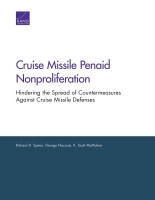| 来源类型 | Research Reports
|
| 规范类型 | 报告
|
| ISBN | 9780833087706
|
| 来源ID | RR-743-DTRA
|
| Cruise Missile Penaid Nonproliferation: Hindering the Spread of Countermeasures Against Cruise Missile Defenses |
| Richard H. Speier; George Nacouzi; K. Scott McMahon
|
| 发表日期 | 2014
|
| 出版年 | 2014
|
| 页码 | 62
|
| 语种 | 英语
|
| 结论 |
There Are Established Control Mechanisms to Prevent the Proliferation of Weapons of Mass Destruction- The eight classes of items in the MTCR's Category I are subject to the tightest export restrictions. The MTCR guidelines state that such exports, if they occur at all, must be "rare" and subject to strong provisions with respect to supplier responsibility.
- Category II items can be used to make Category I items, but they are generally dual-use. (That is, they have other purposes, such as for manned aircraft.) Category II exports are subject to greater flexibility but nevertheless require case-by-case export reviews and specific international procedures.
- The MTCR has well-developed procedures for coordinating export decisions among its members. In addition, the United States has legislation providing sanctions against domestic and foreign entities that contribute to missile proliferation.
Eighteen Classes of Technologies and Equipment Related to Cruise Missile Countermeasures Are Likely Candidates for International Export Control- In contrast to ballistic missiles, which deliver their payloads at point targets, cruise missiles can dispense a liquid or powder payload while flying in a line perpendicular to the prevailing wind. This means that cruise missiles can be far more efficient at delivering chemical or biological agents.
- Eighteen penaid-related items applicable to cruise missiles are appropriate for inclusion in MTCR Category II, though three types of items — electromagnetic pulse generators, air defense communication jammers, and standoff delivery capabilities — may pose greater challenges.
- If the end use for an item is determined to be the delivery of weapons of mass destruction, the MTCR guidelines automatically upgrade the item to Category I restrictions.
- A Category II case-by-case review will be needed to determine whether complete cruise missile penaid subsystems are to be used on an unmanned aerial vehicle or on a manned aircraft.
|
| 摘要 |
- The MTCR Category II classification should apply to 18 penaid-related items relevant to cruise missiles, with a case-by-case review to determine whether complete subsystems will be used on an unmanned aerial vehicle or on a manned aircraft.
- To avoid overloading MTCR with these new or revised items, the new items can be nested into the control definitions of larger classes of items. For example, one possibility is to fill in the currently empty Item 5 with a new set of subitems, "penetration aids."
- MTCR controls should stay focused and not extend to home-on-jam subsystems. At least initially, a move to control this capability may extend MTCR controls too far in the direction of standard offensive tactics to suppress defenses.
- The "Stealth" classification in the MTCR is potentially all-inclusive in terms of devices for reduced observables. To avoid confusion, the clarity of the item could be improved by adding additional examples and changing the name of the classification to "Signature Control."
|
| 主题 | Arms Proliferation and Control
; Ballistic Missiles
; Global Security
; Missile Defense
; Weapons of Mass Destruction
|
| URL | https://www.rand.org/pubs/research_reports/RR743.html
|
| 来源智库 | RAND Corporation (United States)
|
| 资源类型 | 智库出版物
|
| 条目标识符 | http://119.78.100.153/handle/2XGU8XDN/107730
|
推荐引用方式
GB/T 7714 |
Richard H. Speier,George Nacouzi,K. Scott McMahon. Cruise Missile Penaid Nonproliferation: Hindering the Spread of Countermeasures Against Cruise Missile Defenses. 2014.
|
|
文件名:
|
x1495316212707.jpg
|
|
格式:
|
JPEG
|

|
文件名:
|
RAND_RR743.pdf
|
|
格式:
|
Adobe PDF
|
除非特别说明,本系统中所有内容都受版权保护,并保留所有权利。